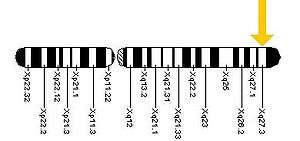Fragile X-associated tremor/ataxia syndrome
| Fragile X-associated tremor/ataxia syndrome | |
|---|---|
 | |
| Location of FMR1 gene | |
| Classification and external resources | |
| OMIM | 300623 |
Fragile X-associated tremor/ataxia syndrome (FXTAS) is a late onset neurodegenerative disorder associated with problems of movement, memory, and the autonomic nervous system. It is related to the disease fragile X syndrome, although FXTAS is a clinically distinct syndrome. In fragile X syndrome (FXS),the fragile X mental retardation 1 gene, FMR1, is silenced; in FXTAS FMR1 is overexpressed and interferes with brain function.
Both FXS and FXTAS are caused by a trinucleotide repeat expansion in FMR1. This CGG repeat expansion is smaller in FXTAS: the disease only occurs in individuals with a Fragile X premutation. It most often occurs in men, but can present in women. There is no cure for FXTAS, but several of the symptoms can be managed with medication.[1]
Symptoms
The physical symptoms of FXTAS include an intention tremor, ataxia, and parkinsonism. This includes small, shuffling steps, muscle rigidity and slowed speech, as well as neuropathic symptoms. As the disease progresses to the more advanced stages, an individual with FXTAS is also at risk of autonomic dysfunction: hypertension, bowel and bladder dysfunction, and impotence.[2]
An individual with FXTAS may also exhibit the following symptoms: a decrease in cognition, which includes diminishing short-term memory and executive function skills, declining math and spelling abilities and decision-making abilities. FXTAS may also result in changes in personality, due to alterations of the limbic area in the brain. This includes increased irritability, angry outbursts, and impulsive behaviour[2]
Prognosis and Medical Management
The progression of symptoms varies widely between each case of FXTAS; the onset of symptoms may be gradual, with progression of the disease spanning multiple years or decades. Alternatively, symptoms may progress rapidly.[3]
The medical management of FXTAS aims to reduce the level of disability and minimize symptoms. Presently, there are many gaps in the research on the management of FXTAS, as the disorder was first described in the literature in 2001. There is no treatment modality aimed at reversing the pathogenesis of FXTAS.[3] However, there are a variety of drug therapies that are being utilized in the management of FXTAS symptoms, although there is a lack of randomized control trials assessing the efficacy these therapies and support is limited to anecdotal evidence.[4] Therefore, many of the treatments are based on what has been helpful in disorders with similar clinical presentations[3]
References
- ↑ Amiri et al. Fragile X–Associated Tremor/Ataxia Syndrome. Archives of Neurology. VOL 65 (NO. 1), Jan 2008
- 1 2 Hagerman, PJ; Hagerman RJ (2004). "Fragile X-associated tremor/ataxia syndrome (FXTAS)". Mental Retardation and Developmental Disabilities Research Reviews. 10 (1): 25–30. doi:10.1002/mrdd.20005.
- 1 2 3 Berry-Kravis, E; Abrams, L.; Coffey, S.M.; Hall, D.A.; Greco, C.; Gane, L.W.; Grigsby, J.; Bourgeois, J.A.; Finucane, B.; Jacquemont, S.; Brunberg, J.A.; Zhang, L.; Lin, J.; Tassone, F.; Hagerman, P.J.; Hagerman, R.J.; Leehey, M.A (2007). "Fragile X-Associated Tremor/Ataxia Syndrome: Clinical Features, Genetics, and Testing Guidelines". Movement Disorders. 22 (14): 2018–2030. doi:10.1002/mds.21493.
- ↑ Hagerman, R.J.; Hall, D.A.; Coffey, S.; Leehey, M.; Bourgeois, J.; Gould, J.; Zhang, L.; Seritan, A.; Berry-Kravis, E; Olichney, J.; Miller, J.W.; Fong, A.L.; Carpenter, R.; Bodine, C.; Gane, L.W.; Rainin, E.; Hagerman, H.; Hagerman, P.J. (2008). "Treatment of fragile X-associated tremor ataxia syndrome (FXTAS) and related neurological problems.". Clinical Intervention in Aging. 3 (2): 251–262.